By Ignacio Ciampitti
Cropping Systems Specialist
KSUCROPS Production Lab
Trends in Kansas
Planting date is one of the primary management practices under the farmer’s control that can highly influence soybean yields, in addition to genetic yield potential and the environment. In recent decades, Kansas producers have been planting soybeans slightly earlier -- at the rate of about one-third day per year (Fig. 1). The past two growing seasons, however, the “50% planting date” mark was achieved at a similar time (first week of June) statewide.
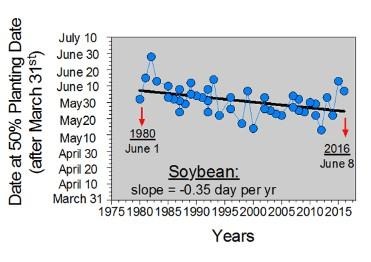
Figure 1. Trend in the date at which 50% of planting progress was achieved for soybean from 1980 to 2016 in Kansas. Source: USDA-NASS.
Kansas planting dates and maturity groups
Soybean can be planted over a wide range of planting dates (Fig. 2, upper panel) with adequate soil moisture conditions, although germination and emergence could be reduced and/or delayed in cool soils (less than 60 degrees F). The recommended maturity groups vary by the area across the state (Fig 2, lower panel).
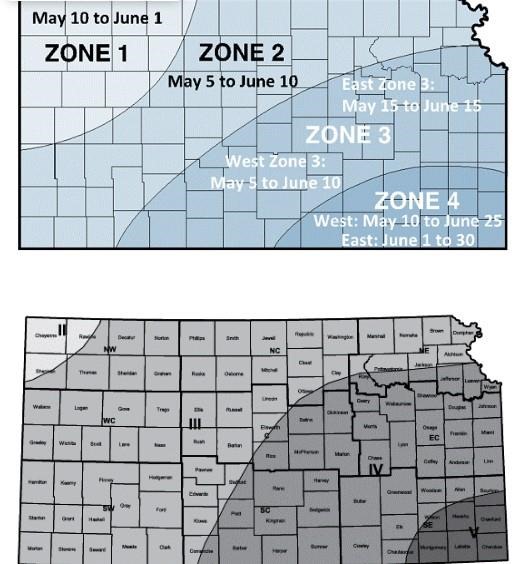
Figures 2. Recommended soybean planting dates (upper panel) and suggested maturity groups (bottom panel) across Kansas.
K-State research: Planting date by maturity group
A summary of four studies on soybean planting date by maturity group performed during the 2014 season is available at: Ciampitti, I. A.; Shoup, D. E.; Sassenrath, G.; Kimball, J.; and Adee, E. A. (2015), Soybean Planting Date × Maturity Group: Eastern Kansas Summary, Kansas Agricultural Experiment Station Research Reports:1:2. http://newprairiepress.org/kaesrr/vol1/iss2/21/
During the 2015 growing season, a similar study was conducted in 5 sites across Kansas. And during the 2016 growing season, a similar study was conducted in 3 sites across Kansas. The optimum combination of soybean planting date x maturity group was governed by the environment (site) evaluated.
In this research, three soybean varieties (early, medium, and late maturity groups) were planted at three planting dates during the 2014, 2015, and 2016 seasons. A full description of all planting dates and maturity groups evaluated is summarized in Table 1.
Table 1. Location, year, planting date, soybean maturity group and water condition.
Location
| | Year | Planting Date | Maturity Group | Water |
Manhattan | 2014 | April 22, May 15, and June 3 | 2.0, 3.8, and 4.8 | Dryland |
Topeka | 2014 | May 2, May 20, and June 18 | 2.0, 3.8, and 4.8 | Irrigated |
Ottawa | 2014 | May 5, May 28, and June 26 | 3.7, 4.2, and 4.8 | Dryland |
Parsons | 2014 | May 2, June 3, and June 26 | 3.9, 4.8, and 5.6 | Dryland |
Hutchinson | 2014 | June 3 and July 2 | 3.7, 4.5, and 5.6 | Dryland |
Manhattan | 2015 | April 14, May 12, and June 5 | 3.0, 3.7, and 4.5 | Dryland |
Rossville | 2015 | April 30, May 13, and June 9 | 3.0, 3.7, and 4.5 | Irrigated |
Ottawa | 2015 | May 4, June 10, and June 29 | 3.7, 4.2, and 4.8 | Dryland |
Parson | 2015 | May 5, June 2, and July 1 | 3.9, 4.8, and 5.6 | Dryland |
Hutchinson | 2015 | April 29, June 10, and July 6 | 3.7, 4.5, and 5.2 | Dryland |
Manhattan | 2016 | April 14, May 5, and June 2 | 3.0, 3.7, and 4.5 | Dryland |
Ottawa | 2016 | June 3, June 23, and July 15 | 3.8, 4.2, and 4.9 | Dryland |
Topeka | 2016 | May 5, May 23, and June 8 | 3.0, 3.9, and 4.5 | Irrigated |
2014 Results
The 2014 yield results of these tests are presented in Figure 3.
Under rainfed conditions at Manhattan, the mid-maturity group (3.8) was the highest-yielding at both early and late planting date. The late maturity group (4.8) outyielded the other maturity groups at the mid planting date (May 15).
Under irrigation at Topeka, group 3.8 and 4.8 (medium and late) varieties maximized yields at the earliest planting date (May 2), with yields above 70 bu/acre. Lower yields were observed for the mid-May planting date, with the exception of the late-maturing group (4.8). For the late planting time (June 18), group 3.8 (yields >60 bu/a) significantly outyielded groups 2.0 and 4.8 (yields <45 bu/a).
Under rainfed conditions at Ottawa, yields were similar, but generally greater for May 28 (mid-planting date) as compared with May 5 (early) across all maturity groups (about 35 bu/acre). At the late planting date (June 26), yields increased with the later maturity groups. At Parsons (rainfed), group 3.9 (early) outyielded the other maturity groups for the May 2 planting date. Conversely, later-maturing soybean groups yielded better at the other planting dates (June 3 and 26). Although a trend in the data supported timing of planting to capture fall rains to enhance yield, the results were not statistically significant between the later maturity groups. At Hutchinson (rainfed), early planting (June 3) produced a significant yield benefit as compared with the late planting time (July 2).
At Ottawa, cumulative precipitation decreased as the planting date was delayed in 2014 (Figure 4). Overall, the later planting date received close to 10 inches less precipitation over the growing season than the early and mid-planting times. Despite that, yields were slightly higher at the later planting dates. For this site, the timing of the rain on the latest planting date was more critical than the quantity. Soybean planted at the early- and mid-planting date received close to 50% of the total rainfall in the first months of the growing season. The importance of adequate moisture for soybean yield development is most apparent from the lower yields for the late planting date at Hutchinson. This location received the lowest cumulative precipitation compared to the early planting date and compared to other locations.
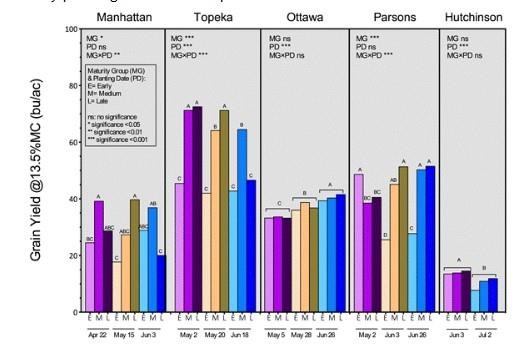
Figure 3. Soybean yields with different planting dates (early, mid, and late) and maturity groups (E = early, M = medium, L = late maturing groups) at five locations across Kansas for the 2014 growing season. Information related to maturity groups (MG) is presented in Table 1.
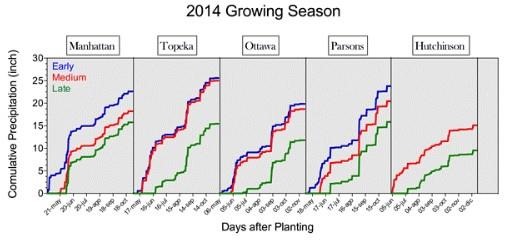
Figure 4. Cumulative precipitation (inches, without including the irrigation at Topeka site) for different planting dates (early, mid, and late) at five locations across Kansas for the 2014 growing season. Information related to specific planting dates per site is presented in Table 1.
2015 Results
The 2015 yield results of these tests are presented in Figure 5.
For the 2015 season at Manhattan, both mid- (3.7) and late-maturity group (4.5) resulted in the highest yield across all planting dates, and outyielded the early-maturity (3.0). Under irrigation at Rossville, the early planting date produced the highest soybean yield (>70 bu/a) in both the mid- (3.7) and late-maturity groups (4.5). At later planting dates, the mid-maturity group (3.7) outyielded both the early and late-maturity groups. Potential soybean yields were reduced when planting date was delayed. Under rainfed conditions at Ottawa, yields were similar for early (May 4) and mid-planting dates (June 10). Yield was reduced when planting on June 29 (late planting date), with a maximum of close to 40 bu/acre. At all planting dates, maturity groups did not present a significant yield difference at Ottawa.
For Parsons, yields in 2015 were strikingly different from those observed in 2014. The lowest yield reported at this site was 53 bu/acre for the earlier maturity group (3.9) for the early planting date. This was greater than any yield reported for any maturity group or planting date in 2014. A trend was documented with the mid-maturity group (4.8) having the highest yield of all cultivars at 75 bu/acre for the earliest planting date. No differences in yield were observed between maturity groups planted at the later dates. While there was a trend for lower yields at the later planting date (58 bu/acre at July 1 vs. 64 bu/acre at June 2 across all cultivars), the difference was not significant.
For Hutchinson, soybean planted at the late April and early June planting dates outyielded the late planting time (July 6) by more than 10 bu/acre. When considering maturity group, the early- and mid-maturity groups (3.7 and 4.5) showed a yield increase for the early June planting date, but a significant decrease for the early July planting time.
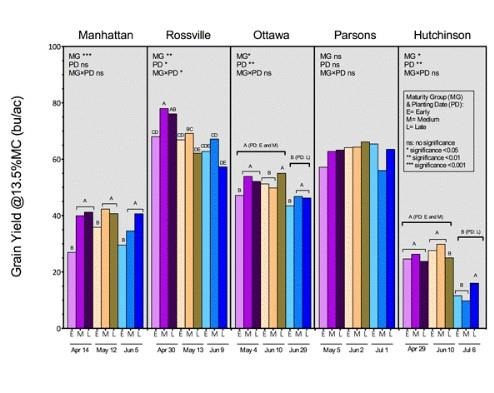
Figure 5. Soybean yields with different planting dates (early, mid, and late) and maturity groups (E = early, M = medium, L = late maturing groups) at five locations across the state of Kansas for 2015 growing season. Information related to maturity groups (MG) is presented in Table 1.
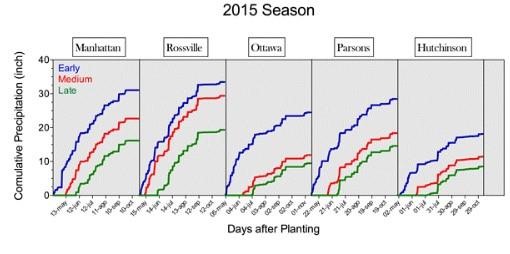
Figure 6. Cumulative precipitation (inches, without including the irrigation at Rossville site) for different planting dates (early, mid, and late) at five locations across the state of Kansas for the 2015 growing season. Information related to specific planting dates per site is presented in Table 1.
At Rossville, the main difference for the latest planting date compared to the early- and mid-planting times was the lower amount of cumulative precipitation received (Fig. 6). At Ottawa, cumulative precipitation decreased from early to mid-and late planting dates. For this site, lower yields were documented for the latest planting date, and this was correlated lower precipitation and timing of the precipitation. Shorter season cultivars suffered from low precipitation during grain-filling. A similar analysis could be extended to the yield pattern measured at Hutchinson during the 2015 growing season. Soybean at the latest planting date received less cumulative precipitation in a shorter growing season, penalizing the crop with an approximately 10 bu/acre yield reduction as compared with early- and mid-planting date.
2016 Results
The 2016 yield results of these tests are presented in Figure 7.
Planting date significantly influenced yields at Manhattan and Ottawa sites. For Manhattan site, the early planting date (April 14) had a 12-bushel yield advantage compared to the late planting date (June 2), (Fig. 7). At the Ottawa site, yields were also higher at the earlier planting dates: early-planted (63 bu/acre) > medium (57 bu/acre) > late-planted (45 bu/acre). For Manhattan and Ottawa, MG did not significantly influence yields. At the Topeka site (irrigated), yields for the early and medium planting dates, averaged 67 bu/acre. The late-planted beans yielded only 61 bu/acre. At the Topeka site, the early and medium MGs outyielded the late variety by 9 bushels (63 compared to 54 bu/acre).
Cumulative precipitation at the Manhattan site favored early season growth for beans at the early planting date, with small differences for the medium- and late-planted scenarios (Fig. 8). At the Topeka and Ottawa sites, cumulative precipitation was similar across all planting dates, with a larger separation between the medium- and late-planting dates for Topeka relative to Ottawa site.
In summary for the 2016 season, the main factor influencing yield at Manhattan and Ottawa was planting date – with higher yields at the earlier planting dates. Later planting dates reduced the overall length of the growing season, which diminished maximum yield potential, in addition to other factors that could have limited yields (i.e. insects, disease, etc.). At the Topeka irrigated site, yields were lower with the shortest MG, with a 15% overall yield reduction (across all planting dates).
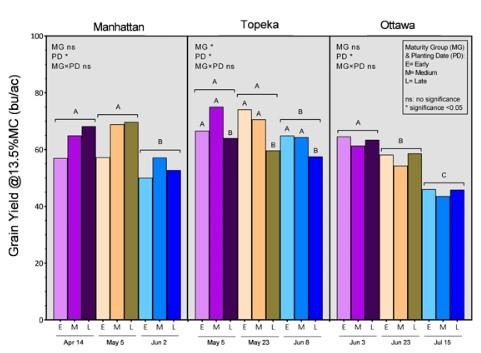
Figure 7. Soybean yields with different planting dates (early, mid, and late) and maturity groups (E = early, M = medium, L = late maturing groups) at three locations across the state of Kansas for 2016 growing season.
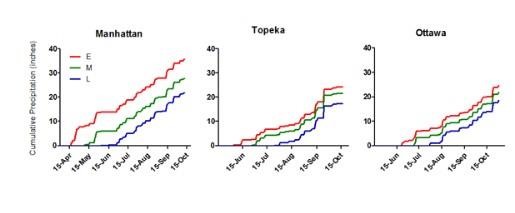
Figure 8. Cumulative precipitation (inches) for all soybean studies with different planting dates (early, mid, and late) at three locations across Kansas during the 2016 growing season. Information related to planting dates per site is presented in Table 1.
Conclusions and recommendations
- Ultimately, weather patterns dictate soybean yields, especially under dryland conditions. There is no guarantee that any certain planting date will always work out the best when it comes to soybean yields in Kansas. In fact, the distribution and amount of rainfall and the day/night temperature variations around flowering and during the grain filling periods have large impacts in defining soybean yield potential. Thus, when the risk of drought stress during the growing season is high, diversifying planting dates may be a good approach to consider.
- When planting early, seed should be treated with a fungicide and insecticide. Selecting varieties with resistance to soybean cyst nematode and sudden death syndrome is advisable. Do not plant into soils that are too wet, however. Also, do not plant until soil temperatures are close to 60 degrees F. If planted into soils cooler than that, seedlings may eventually emerge but will have poor vigor.
- In drier areas of Kansas and on shallow soils, yields have been most consistent when planting soybeans in late May to early June. By planting in that timeframe, soybeans will bloom and fill seed in August and early September, when nights are cooler and the worst of heat and drought stress is usually over.
- In our 2014, 2015, and 2016 planting date by maturity group studies, interactions with the environment were the primary factor in the yields and maturity group responses. Under full irrigation, the earliest planting date maximized yields for cultivars from the late 3, mid- and late 4 maturity groups at Topeka and Rossville sites. For our rainfed sites (2014, 2015, and 2016), no single rule can apply to all conditions, but late planting (late June) showed good yields at Ottawa and Parsons for later-maturing groups in 2014, with a different pattern for the 2015 and 2016 seasons (for example, Ottawa had the highest yields at early and mid-planting dates those years).
- Cumulative amount and timing of precipitation primarily influenced soybean planted later in the growing season.
- New studies are planned for the 2017 growing season for similar locations.
Source:ksu.edu